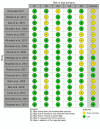Efficacy and Safety of Vancomycin, Linezolid, and Ceftaroline in the Treatment of Methicillin-Resistant Staphylococcus aureus (MRSA): A Systematic Review and Meta-Analysis
- PMID: 39996230
- PMCID: PMC11848488
- DOI: 10.7759/cureus.77949
Efficacy and Safety of Vancomycin, Linezolid, and Ceftaroline in the Treatment of Methicillin-Resistant Staphylococcus aureus (MRSA): A Systematic Review and Meta-Analysis
Abstract
Methicillin-resistant Staphylococcus aureus (MRSA) is one of the world's most serious healthcare issues, causing morbidity, mortality, and high healthcare costs, making effective treatment strategies essential. This meta-analysis assessed the comparative effectiveness and safety of ceftaroline, linezolid, and vancomycin in treating MRSA infections. Searches were undertaken across major electronic databases, including PubMed, Cochrane CENTRAL, Embase, and Web of Science, from 2000 to 2024. A total of 24 studies (17 randomized controlled trials (RCTs) and seven observational studies) involving 11,332 patients met the inclusion criteria. Patients on vancomycin treatment were more likely to have lower odds of being cured than controls (OR 0.68; 95% CI (0.58, 0.81), p < 0.0001), especially when compared to linezolid (OR 0.61; 95% CI (0.49, 0.74), p < 0.00001). Furthermore, mortality rates were significantly higher in vancomycin-treated patients than in controls (OR 1.25; 95% CI (1.00, 1.56), p = 0.05) and more precisely than in linezolid (OR 1.29; 95% CI (1.03, 1.62), p = 0.03). Microbiological eradication rates were not statistically different between vancomycin and the comparators (OR, 0.82; 95% CI (0.63, 1.07), p = 0.14). Safety analysis demonstrated comparable adverse event profiles between vancomycin and linezolid for thrombocytopenia, anemia, and hepatotoxicity. Although vancomycin remains a viable option owing to its accessibility and cost-effectiveness, our findings suggest that newer alternatives, particularly linezolid, may offer superior clinical outcomes in specific MRSA infections, especially in cases of pneumonia or high-risk patients. These results have important implications for clinical practice and antimicrobial stewardship programs and support a more nuanced approach to MRSA treatment based on patient-specific factors, infection characteristics, and local resources.
Keywords: ceftaroline; linezolid; mortality rates; mrsa infections; thrombocytopenia; vancomycin.
Copyright © 2025, Dighriri et al.
Conflict of interest statement
Conflicts of interest: In compliance with the ICMJE uniform disclosure form, all authors declare the following: Payment/services info: All authors have declared that no financial support was received from any organization for the submitted work. Financial relationships: All authors have declared that they have no financial relationships at present or within the previous three years with any organizations that might have an interest in the submitted work. Other relationships: All authors have declared that there are no other relationships or activities that could appear to have influenced the submitted work.
Figures






References
-
- Vital signs: epidemiology and recent trends in methicillin-resistant and in methicillin-susceptible Staphylococcus aureus bloodstream infections - United States. Kourtis AP, Hatfield K, Baggs J, et al. https://www.cdc.gov/mmwr/volumes/68/wr/mm6809e1.htm. MMWR Morb Mortal Wkly Rep. 2019;68:214–219. - PMC - PubMed
Publication types
LinkOut - more resources
Full Text Sources
Miscellaneous
